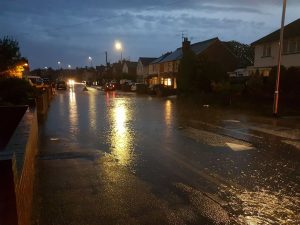By Dr Rob Thompson, Department of Meteorology, University of Reading

Last night Reading experienced an immense thunderstorm, like something I’d previously only experienced in the tropics.
Driving conditions were horrendous, with incredibly reduced visibility and water simply unable to clear the roads quickly enough – I had the misfortune to be out in it.
To me, the rain was the impressive thing, but then my research is on rain, so I’m very aware of it. But to others the real experience was the lightning. There was a lot of lightning, both sheet and fork lightning. More than 100,000 strikes over the UK, you can see the strikes on the map below.
But, as I’ve said, the really impressive thing for me was the rain rate, and how sustained it was. Very high rainfall rates are not that uncommon, but lasting more than a few minutes is very unusual.

The University of Reading observatory publishes live and historic weather data. Its tipping bucket rain gauge got 38.6 mm in the storm, and 1.6 mm in the little shower 20 minutes before the big storm. The gauge experienced 35 mm of that total in 45 minutes, a phenomenal amount, averaging 47 mm/hr for three quarters of an hour.
Let’s put that in perspective. How much rain is that? Well the University of Reading campus gets approximately 640 mm per year on average, so we had 5.5% of the annual rain in 45 minutes. You can see the one-minute rainfall rates in the figure below.
There was a further storm, later in the night, that added to the total, leaving the University officially recording 45.1 mm in the 0900 (GMT) measurement. That was the wettest day since 18 August 2011 and the wettest July day since 22 July 1967 (just under 50 years ago). That 45.1 mm in the day is more than fell in half of the last 18 months.

So a lot of lightning, a lot of water and a very big storm. Thunderstorms can be very hard to forecast, and their exact timing and location are a particular challenge. For a few days, warnings had been issued of such events as yesterday, but they are not location-specific.
Ongoing research in the Flooding From Intense Rainfall research programme is investigating how better warnings can be made of such events, how to better predict the storms and then the flood impacts they have. Looking to the future, more specific warnings help emergency responses as well as the public.
